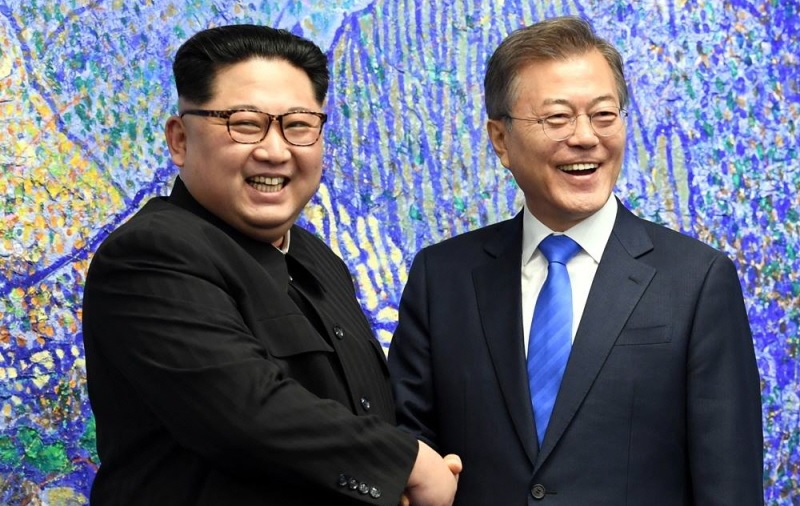 Images
Images of the leaders of South and North Korea, Moon Jae-in and Kim Jong-un, laughing, smiling and even hugging, are incredibly powerful. They represent the hope that the Korean peninsula is actually entering a
new era of peace. But turning that hope into a reality will require more than crisis diplomacy.
Crisis diplomacy is interaction between states (and non-state actors) under a heightened threat of systemic change or conflict. There are usually just two sides to crisis diplomacy. The aggressor uses provocation and the threat of expanded conflict to force a partner to back down in order to secure objectives. The respondent manages or resolves potential conflict in order to avoid descent into expanded, unmanageable conflict.
On the Korean peninsula, North Korea has been in the aggressor role, while South Korea has been the respondent. The hallmarks of crisis diplomacy—armed infiltrations, assassination attempts, artillery exchanges and naval skirmishes—are a recurring feature of North–South diplomatic interaction.
Crisis diplomacy is a process. It involves high-level decision-making and close political control over military engagement; close coordination between partners and allies; and clear signalling to avoid miscalculation and inadvertent escalation. Actors must set limited, achievable goals and be prepared to accept compromises.
Since the 1990s, crisis diplomacy on the Korean peninsula has followed a trajectory in which North Korea undertakes limited, often non-directly attributable provocations and South Korea manages, de-escalates and then regroups. South Korea’s initiatives to engage North Korea have been marked by the pursuit of high-level access—often leadership summits or close coordination with the US. These initiatives achieved limited objectives—namely, the cessation of the risk of immediate conflict—and have meant accepting options that were previously considered outside the range of acceptable choices, such as economic inducements and financial rewards.
However, the value of crisis diplomacy, and its marketability to stakeholders, reduces as the threat decreases. This effectively places a time limit on associated diplomatic initiatives. Accordingly, while crisis diplomacy provides a set of tools that work for managing and avoiding conflict (or, for the aggressor, achieving limited gains), it doesn’t provide an appropriate set of tools for transforming the root causes of tension.
The dynamic on the Korean peninsula changed with the decision of the Trump administration to reverse these roles. By increasing tension, and threatening escalation, the US assumed an aggressor role. That left South Korea alone in the crisis diplomacy respondent role—on two fronts.
South Korea’s efforts fitted neatly into the mould of crisis diplomacy. The two North–South leadership summits, close coordination with the US and a
North Korea – US leadership summit reduced the threat of immediate conflict. Further leadership summits may provide a rationale for economic inducements and financial rewards—in this case, the cessation of sanctions and the opening of joint economic projects.
Crisis diplomacy is limited, regardless of whether we assess the root causes of tension to be North Korea’s
nuclear forces and missile programs;
conventional forces and intermittent provocations; or political system and
insecurity. Leadership summits may provide the confidence and political push to start or finalise negotiations, but they inevitably tempt cynicism.
More innovative, creative diplomacy and coalition-building is required to overcome deeply entrenched, intractable international problems.
There are examples that demonstrate how combinations of states overcame deeply entrenched international problems. In 1986, Australia, in coordination with a number of agricultural exporting states, formed the Cairns Group, and overcame major-power opposition to multilateral trade liberalisation in agriculture. In the early 1990s, Australia, Canada and Japan led efforts towards the Paris peace accords and the securing of a lasting Cambodian peace settlement. In the early 2000s, Canada led an international effort to reassess and reinterpret sovereignty and intervention.
The lull in security tension on the Korean peninsula provides an opportunity to make a similarly lasting change. But the Moon administration must act now.
Five-year presidential terms, a combination of a strong executive and weaker legislative and administrative arms, a weak party system, and a strong preference for differentiation between administrations limit South Korea’s
foreign policy continuity, which in turn limits its capacity to sustain initiatives between administrations. Without a diplomatic process that strengthens domestic support, or provides a degree of shelf life, successes achieved through crisis diplomacy will disappear. A crowded global diplomatic agenda further restricts the time available.
There are diplomatic processes available to secure a more durable, longer-lasting process. But the Moon administration must seek them out. At the moment, however, there are no signs that it plans to move beyond the unimaginative, often tried but ultimately fruitless, confines of crisis diplomacy.
 Print This Post
Print This Post